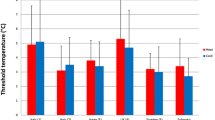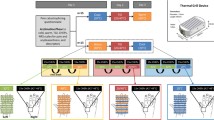Summary
Hand cooling and resulting comfort and pain were studied in 12 subjects, while touching six different materials (polyurethane foam, wood, nylon, rustproof steel, aluminium, and temperature-controlled metal) which were initially at ambient temperature. This was done for three ambient temperatures (-10°, 0° and 10° C), after pre-exposure exercise or rest, with bare hands or while wearing gloves. The observed cooling curves were analysed as Newtonian cooling curves. The observed time constants appeared to be significantly related to the materials' contact coefficients, the presence of hand protection, the preceding activity, and the interaction between contact coefficient and the presence of hand protection. These parameters also allowed a good description of the time constant (r 2=0.8) of the related cooling curves. Thermal and pain sensation could be described in terms of the local skin temperature, ambient temperature and hand protection. Equal pain and thermal levels were associated with lower temperatures of the back of the hand than of the contact side. The slightly painful condition was associated with a skin temperature of 16° C for the back and 19° C for the palm of the hand. The pain level appeared to be inversely related to cooling speed. Skin freezing occurred at higher skin temperatures when touching cold objects than when exposed to cold air as a result of reduced supercooling. The regression equations determined allowed calculations to be made of safety limits for hand cooling while in contact with a wide range of materials.
Similar content being viewed by others
References
BSI (1978) Safety of household and similar electrical appliances. BS 3456, part 101. British Standards Institute, London
Chatonnet J, Cabanac M (1965) The perception of thermal comfort. Int J Biometeor 9:183–193
Enander A (1982) Perception of hand cooling during local cold air exposure at three different temperatures. Ergonomics 25:351–361
Enander A (1984) Performance and sensory aspects of work in cold environments: a review. Ergonomics 27:365–378
Enander A (1986) Sensory reactions and performance in moderate cold. Arbete och Htilsa 32, ISBN 91-7464-318-5, Sölna
Fox WF (1967) Human performance in the cold. Hum Factors 9:203–220
Hellström B (1965) Local effects of acclimatization to cold in man. University Press, Oslo
Keatinge WR, Cannon P (1960) Freezing point of human skin. The Lancet 1:11–14
Lewis T, Love WS (1926) Vascular reactions of skin to injury; effects of freezing, of cooling and of warming. Heart 13:27–60
Mackworth NH (1953) Finger numbness in very cold winds. J Appl Physiol 5:533–543
Molnar GW (1971) Analysis of the rate of digital cooling. J Physiol (Paris) 63:350–352
Molnar GW, Wilson O, Goldman RF (1972) Analysis of events leading to frostbite. Int J Biometeor 16:247–258
Molnar GW, Hughes AL, Wilson O, Goldman RF (1973) Effect of skin wetting on finger cooling and freezing. J Appl Physiol 35:205–207
Morton R, Provins KA (1960) Finger numbness after acute local exposure to cold. J Appl Physiol 15:149–154
Raman ER, Vanhuyse VJ (1975) Temperature dependence of the circulation pattern in the upper extremities. J Appl Physiol 249:197–210
Schiefer RE, Kok R, Lewis MI, Meese GB (1984) Finger skin temperature and manual dexterity-some inter group differences. Appl Ergon 15:135–141
Teichner WH (1957) Manual dexterity in the cold. J Appl Physiol 11:333–338
Wilson O, Goldman RF (1970) Role of air temperature and wind in the time necessary for a finger to freeze. J Appl Physiol 29:658–664
Wilson O, Goldman RF, Molnar GW (1976) Freezing temperature of finger skin. J Appl Physiol 41:551–558
Yoshida A, Matsui I, Taya H (1989) References on contact with hot and cold surfaces, tactile warmth and warmth of floors. Technical Report ISO/TC159/SC5/WG1/187, International Standardization Organization, Geneva
Author information
Authors and Affiliations
Rights and permissions
About this article
Cite this article
Havenith, G., van de Linde, E.J.G. & Heus, R. Pain, thermal sensation and cooling rates of hands while touching cold materials. Europ. J. Appl. Physiol. 65, 43–51 (1992). https://doi.org/10.1007/BF01466273
Accepted:
Issue Date:
DOI: https://doi.org/10.1007/BF01466273




